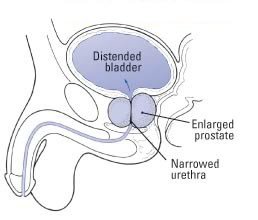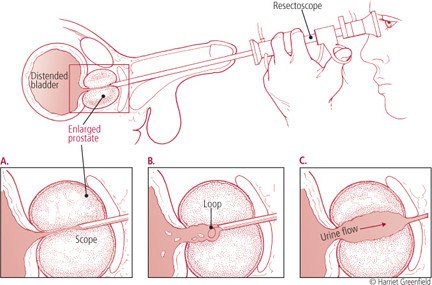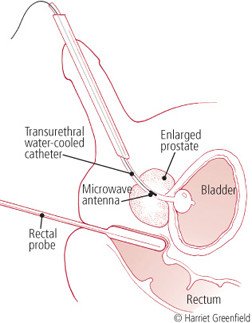Enlarged prostate (benign prostatic hyperplasia)
Medically reviewed by Drugs.com. Last updated on Dec 5, 2022.
What is an Enlarged prostate (benign prostatic hyperplasia)?

The prostate is a small gland approximately the size and shape of a walnut. It sits directly below the bladder, in front of the rectum. The prostate is a part of the male reproductive tract. It produces fluid that combines with sperm to make semen.
At birth, the prostate gland is tiny. When testosterone levels rise during puberty, the prostate grows rapidly, doubling in size by age 20. Growth slows down for the next two decades and the prostate usually does not cause problems for many years. Less than 10% of 30-year-old men have an enlarged prostate. When a man reaches his 40s, the prostate goes through a second growth spurt. Half of all men have an enlarged prostate by the time they reach age 60, and by age 85, 90% of men have an enlarged prostate.
The prostate surrounds the tube that carries urine from the bladder (urethra). During puberty, the prostate expands evenly. The enlargement that occurs in the second half of life, however, is concentrated in the part of the gland next to the urethra. As the gland gets bigger, it interferes with the flow of urine out of the bladder. That makes the bladder work harder to empty urine. Over time, the problem worsens, and eventually not all the urine can be emptied. The bladder wall also may become thickened, which can result in muscle spasms.
|
|
Symptoms
An enlarged prostate can make it more difficult to urinate. Not all men who have an enlarged prostate experience symptoms. However, about one-fourth of all men in the United States report some trouble urinating.
At first, symptoms may be mild because the bladder muscle is able to compensate for the pressure from the enlarged prostate on the urethra.
The pressure of the prostate on the urethra causes an interrupted or weak stream of urine. Other symptoms include:
- difficulty starting to urinate
- continuing to dribble after urination
- a feeling that you have not completely emptied your bladder.
The severity of these problems depends on how much pressure the prostate is putting on the urethra.
Another set of symptoms happens when the urine that collects in the bladder causes irritation. These symptoms include:
- painful urination
- a frequent need to empty the bladder, especially at night
- a feeling of urgency that accompanies the sensation to urinate
- loss of bladder control (incontinence).
Potentially serious complications can occur if the bladder does not empty completely. Urine that does not exit the bladder can lead to the growth of bacteria, which can cause frequent urinary tract infections. Also, urinary stones can form in the bladder lining due to an accumulation of debris and chemicals. Broken blood vessels can cause blood in the urine, often because of torn or enlarged veins on the inner surface of the prostate. Blood in the urine also can be caused by the sudden stretching of the bladder wall. If left untreated, urine retained in the bladder can back up into the kidneys, which can cause kidney failure over time.
Diagnosis
Your doctor will ask questions to rate the severity of your urinary symptoms. The doctor will do a digital rectal exam to feel the size, shape and consistency of the prostate gland. Usually, a sample of your urine will be examined for blood or evidence of infection.
Occasionally, your doctor may order tests, such as an ultrasound, to measure the amount of urine in your bladder, or a cytoscopy, in which a lighted tube is inserted through the penis into the bladder. Special tests also can be done to evaluate the muscles and nerves in the bladder, especially if you are having trouble with leakage of urine.
Expected duration
Symptoms from an enlarged prostate are not always related directly to the size of the gland. Many men with an enlarged prostate don't have any symptoms. In other men, the symptoms are mild and worsen slowly enough that they never develop serious problems. About one-third of men with enlarged prostates have symptoms that continue to worsen and require treatment.
Prevention
Although you cannot prevent the prostate from enlarging, you can take measures to reduce your symptoms:
- Limit your intake of liquids in the evening, especially drinks containing alcohol and caffeine. Cutting back helps to minimize the number of times you have to urinate during the night. (Also, drinking too much alcohol may irritate the bladder or prostate. Most experts recommend that men avoid more than two alcoholic drinks a day.)
- Ask your doctor whether you can change or eliminate medications that may be aggravating the problem. These medications include antihistamines, diuretics, decongestants, antispasmodics, tranquilizers and certain types of antidepressants. These can weaken the bladder muscle or narrow the opening of the prostate.
- Take every opportunity to use the bathroom and allow yourself enough time to empty your bladder completely.
Treatment
When to seek treatment and what action to take are personal decisions you should make with your doctor's input. The main reason to start treatment is that you are bothered by symptoms, or that changes in your urination are interfering with your lifestyle. It is rare for men with little or no symptoms to need treatment of any kind.
Here are three treatment approaches:
Watchful waiting
If your symptoms are not severe, see your doctor only as needed.
Medications
Drugs called alpha-blockers help to relax the muscles at the base of the bladder and increase a man's ability to urinate. Approximately 70% of men see improvement in their symptoms within a few days to a few weeks after beginning one of these medications. On the down side, alpha-blockers can cause dizziness, fatigue and excessively low blood pressure. Commonly prescribed alpha-blockers include tamsulosin (Flomax), alfuzosin (UroXatral), doxazosin (Cardura) and terazosin (Hytrin).
For some men, drugs that block testosterone can shrink the size of the prostate and increase the flow of urine. The drawbacks to this type of drug are that it can take three to six months to begin working, and that it can cause impotence in approximately 4% of men who take it. Commonly prescribed testosterone blockers, also known as 5 alpha reductase inhibitors, include finasteride (Proscar) and dutasteride (Avodart).
Recent studies suggest that combining an alpha-blocker with a testosterone blocker may work better than either drug alone.
Surgery
This option offers the best chance for improving symptoms but also carries the greatest risk of complications. There are several types of surgical procedures, such as:
- Transurethral resection of the prostate (TURP)— The surgeon inserts a telescope and an electrical loop through the urethra to the enlarged prostate. The electrical loop burns away the extra prostate tissue to open the urethral passage. The operation takes approximately 90 minutes. It involves either general or spinal anesthesia and an overnight hospital stay. The most common side effect is retrograde ejaculation, in which semen flows into the bladder rather than out the end of the penis, and results in "dry" orgasms.
|
|
- Transurethral incision of the prostate (TUIP)— This surgery widens the urethra by making small cuts in the bladder opening, rather than removing prostate tissue. It is used only when there is minimal enlargement of the prostate. This procedure has the advantage of a low complication rate and no overnight hospital stay. However, long-term results may not be as good as those seen with TURP.
- Transurethral microwave thermotherapy (TUMT)— A microwave antenna is inserted into the urethra to heat the prostate and destroy overgrown tissue. This procedure costs less than TURP and has fewer complications. No overnight hospital stay is needed. However, approximately half of all men need additional treatment within four years.
|
|
- Transurethral needle ablation of the prostate (TUNA)— This procedure uses a heated needle to burn away small amounts of prostate tissue. Like TUMT, this procedure costs less than TURP and has fewer complications. Also, no overnight hospital stay is needed.
- Transurethral ultrasound-guided laser-induced prostatectomy (TULIP)— Using ultrasound as a guide, a surgeon removes overgrown prostate tissue with a laser beam. A variation of this procedure that uses a telescope rather than ultrasound is called visualized laser assisted prostatectomy (VLAP).
While surgery usually is done as an elective procedure, some men need to have surgery if their bladder becomes blocked completely.
- Open surgery— Occasionally, a very large prostate may require an incision above the pubic bone.
Treatment options
The following list of medications are related to or used in the treatment of this condition.
When to call a professional
Call your doctor if you have bothersome symptoms or if you notice blood in your urine. If your urine flow stops completely, seek immediate care. You also should seek medical care if you experience symptoms of a urinary tract infection.
Prognosis
Medical and surgical treatments both are likely to relieve symptoms. Surgery is slightly more successful in relieving symptoms, but the risk of complications is greater.
Additional info
National Institute of Diabetes & Digestive & Kidney Disorders
https://www.niddk.nih.gov/
Learn more about Enlarged prostate
- Anticholinergic Drugs to Avoid in the Elderly
- Benign Prostatic Hyperplasia (BPH): Symptoms and Treatment
- Enlarged Prostate (BPH) Medications and Alcohol Interactions
Treatment options
Medicine.com guides (external)
Further information
Always consult your healthcare provider to ensure the information displayed on this page applies to your personal circumstances.



